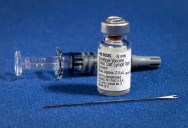This Day In History – October 26th

THE ERIE CANAL OFFICIALLY OPENS – OCTOBER 26, 1825

Photograph by Clifton Park Collection
The Erie Canal is a waterway in New York that runs about 363 miles (584 km) from Albany, New York, on the Hudson River to Buffalo, New York, at Lake Erie, completing a navigable water route from the Atlantic Ocean to the Great Lakes. The canal contains 36 locks and encompasses a total elevation differential of around 565 ft. (169 m). First proposed in 1807, it was under construction from 1817 to 1825 and officially opened on October 26, 1825.
It was the first transportation system between the eastern seaboard (New York City) and the western interior (Great Lakes) of the United States that did not require portage, was faster than carts pulled by draft animals, and cut transport costs by about 95%. The canal fostered a population surge in western New York state, opened regions farther west to settlement, and helped New York City become the chief U.S. port. It was enlarged between 1834 and 1862. In 1918, the enlarged canal was replaced by the larger New York State Barge Canal.
Today, it is part of the New York State Canal System. In 2000, the United States Congress designated the Erie Canalway National Heritage Corridor to recognize the national significance of the canal system as the most successful and influential human-built waterway and one of the most important works of civil engineering and construction in North America. [Source]

An aerial view of downtown Rochester, probably in the late 1930s, showing the Genesee River flowing through the center of the city. In the foreground, over the river, is the Court Street dam, followed by the Court Street, Broad Street, Main Street, Andrews Street and Central Avenue bridges. In the far left, the Genesee gorge is shown below the Upper Falls. Photograph by City Hall Lab vintage collection
THE GUNFIGHT AT THE O.K. CORRAL – OCTOBER 26, 1881

The Gunfight at the O.K. Corral was a roughly 30-second gunfight that took place at about 3:00 p.m. on Wednesday October 26, 1881 in Tombstone, Arizona Territory, Cochise County, of the United States. Frank and Tom McLaury and Billy Clanton were killed; Morgan Earp, Virgil Earp, and Doc Holliday were wounded and survived. Wyatt Earp was the only individual who came through the fight unharmed. It is generally regarded as the most famous gunfight in the history of the Old West and has come to represent a time in American history when the frontier was open range for outlaws who were confronted by law enforcement that was often sparse, or nonexistent.
Despite its name, the gunfight actually occurred in a narrow lot six doors west of the rear entrance to the O.K. Corral on Fremont Street. The two opposing parties were initially only about 6 feet (1.8 m) apart. About thirty shots were fired in thirty seconds. Ike Clanton and Billy Claiborne ran from the fight, unharmed. The Earps and Doc Holliday were charged by Billy Clanton’s brother, Ike Clanton, with murder but were eventually exonerated by a local judge after a 30-day preliminary hearing and then again by a local grand jury.
On December 28, 1881, Virgil Earp was maimed in an assassination attempt by outlaw Cowboys, and on March 19, 1882, they assassinated Morgan Earp. This led to a series of further killings and retributions, with federal and county lawmen supporting different sides of the conflict, which became known as the Earp Vendetta Ride. [Source]

Photograph by Wilson44691
The P-51 MUSTANG MAKES ITS MAIDEN FLIGHT – OCT. 26, 1940

Photograph by PD-USGOV-Military
The North American Aviation P-51 Mustang was an American long-range, single-seat fighter and fighter-bomber used during World War II, the Korean War and in several other conflicts. During World War II Mustang pilots claimed 4,950 enemy aircraft shot down, the most of any Allied fighter.
At the start of Korean War the Mustang was the main fighter used by the United Nations. However, jet fighters, including the F-86, took over this role, and the Mustang became a specialized ground-attack fighter-bomber. Despite the advent of jet fighters, the Mustang remained in service with some air forces until the early 1980s. After World War II and the Korean War, many Mustangs were converted for civilian use, especially air racing. [Source]

A P-51 Mustang releases two napalm bombs over industrial military targets in North Korea. Photograph by USAF
THE ERADICATION OF SMALLPOX IS DECLARED – OCTOBER 26, 1979/80

Photograph by CDC/James Hicks
Smallpox was an infectious disease unique to humans, caused by either of two virus variants, Variola major and Variola minor. The disease is also known by the Latin names Variola or Variola vera, which is a derivative of the Latin varius, meaning “spotted”, or varus, meaning “pimple”. The term “smallpox” was first used in Europe in the 15th century to distinguish variola from the “great pox” (syphilis).
Smallpox localizes in small blood vessels of the skin and in the mouth and throat. In the skin, this results in a characteristic maculopapular rash, and later, raised fluid-filled blisters. V. major produces a more serious disease and has an overall mortality rate of 30–35%. V. minor causes a milder form of disease (also known as alastrim, cottonpox, milkpox, whitepox, and Cuban itch) which kills about 1% of its victims. Long-term complications of V. major infection include characteristic scars, commonly on the face, which occur in 65–85% of survivors.
The disease killed an estimated 400,000 Europeans per year during the closing years of the 18th century (including five reigning monarchs), and was responsible for a third of all blindness. Of all those infected, 20–60%—and over 80% of infected children—died from the disease. Smallpox was responsible for an estimated 300–500 million deaths during the 20th century. As recently as 1967, the World Health Organization (WHO) estimated that 15 million people contracted the disease and that two million died in that year.
After vaccination campaigns throughout the 19th and 20th centuries, the WHO certified the eradication of smallpox in 1979. Smallpox is one of the two infectious diseases to have been eradicated, the other being rinderpest, which was declared eradicated in 2011. [Source]

Photograph by James Gathany

This 1980 photograph taken at the Centers for Disease Control, depicted three former directors of the Global Smallpox Eradication Program as they read the good news that smallpox had been eradicated on a global scale. From left to right, Dr. J. Donald Millar, who was Director from 1966 to 1970; Dr. William H. Foege, who was Director from 1970 to 1973, and Dr. J. Michael Lane, who was Director from 1973 to 1981.
The worldwide eradication of this dreaded virus was due to the Smallpox Eradication Campaign of the late 1960’s, early 1970s, whereupon, a mass-vaccination program was instituted across the globe that lead to the declaration in 1978 by a global commission that smallpox had been eradicated, which was officially accepted by the 33rd World Health Assembly in 1980. Photograph by CDC
PRESIDENT OF SOUTH KOREA, PARK CHUNG-HEE IS ASSASSINATED
OCTOBER 26, 1979

Park Chung-hee, president of South Korea, was assassinated by Kim Jae-kyu, his security chief as the director of Korean Central Intelligence Agency (KCIA), on Friday, October 26, 1979 at 7:41pm during a dinner at a KCIA safehouse inside the Blue House presidential compound in Seoul. It is simply known as “10.26” or the “10.26 incident” in South Korea.
There is a great deal of controversy on Kim’s motive and whether it was a planned attempt for coup d’etat or an impulsive act. The chief investigator Yi Hak-bong famously concluded that it was too careless for a deliberate act and yet too elaborate for an impulsive act.
By the time of his assassination, President Park had ruled South Korea for 18 years with dictatorial power and draconian martial laws after his military coup in 1961. Kim claimed that Park was an obstacle to democracy and that his act was one of patriotism. After Kim shot the president to death and the leader of his guards, his agents quickly killed four more of the presidential bodyguards before the group was apprehended.
When Chief of Staff Jeong learned of what happened from Chief Secretary Kim, he ordered Major General Chun Doo-hwan, commander of Security Command who later became the president of South Korea through a military coup, to arrest Director Kim and investigate the incident. Director Kim was arrested after he was lured to a secluded area outside Army HQ on the pretext of meeting with Army Chief of Staff. Eventually, everyone involved in the assassination was arrested, tortured, and later executed. [Source]
‘BABY FAE’ RECEIVES HEART TRANSPLANT FROM BABOON
OCTOBER 26, 1984

Stephanie Fae Beauclair (October 14, 1984 – November 15, 1984), better known as Baby Fae, was an American infant born in 1984 with hypoplastic left heart syndrome. She became the first infant subject of a xenotransplant procedure, receiving the heart of a baboon. The procedure, performed by Leonard L. Bailey at Loma Linda University Medical Center, initially appeared to be successful, but Fae died 21 days later of a kidney infection. The procedure was subject to a wide ethical and legal debate. [Source]
Xenotransplantation is the transplantation of living cells, tissues or organs from one species to another. Such cells, tissues or organs are called xenografts or xenotransplants. In contrast, the term allotransplantation refers to a same-species transplant. Human xenotransplantation offers a potential treatment for end-stage organ failure, a significant health problem in parts of the industrialized world. It also raises many novel medical, legal and ethical issues. [Source]

PRESIDENT GEORGE W. BUSH SIGNS THE PATRIOT ACT
OCTOBER 26, 2001

Photograph by Ron Sachs/Corbis Images
The USA PATRIOT Act (commonly known as the “Patriot Act”) is an Act of the U.S. Congress that was signed into law by President George W. Bush on October 26, 2001. The title of the act is a ten letter acronym (USA PATRIOT) that stands for: Uniting (and) Strengthening America (by) Providing Appropriate Tools Required (to) Intercept (and) Obstruct Terrorism Act of 2001.
The act, a response to the terrorist attacks of September 11th, dramatically reduced restrictions on law enforcement agencies’ ability to search telephone, e-mail communications, medical, financial, and other records; eased restrictions on foreign intelligence gathering within the United States; expanded the Secretary of the Treasury’s authority to regulate financial transactions, particularly those involving foreign individuals and entities; and broadened the discretion of law enforcement and immigration authorities in detaining and deporting immigrants suspected of terrorism-related acts. The act also expanded the definition of terrorism to include domestic terrorism, thus enlarging the number of activities to which the USA PATRIOT Act’s expanded law enforcement powers can be applied.
On May 26, 2011, President Barack Obama signed a four-year extension of three key provisions in the USA PATRIOT Act: roving wiretaps, searches of business records (the “library records provision”), and conducting surveillance of “lone wolves” — individuals suspected of terrorist-related activities not linked to terrorist groups. [Source]
THE MOSCOW THEATER HOSTAGE CRISIS ENDS – OCTOBER 26, 2002

The Moscow theater hostage crisis, also known as the 2002 Nord-Ost siege, was the seizure of a crowded Moscow theater on 23 October 2002 by some 40 to 50 armed Chechens who claimed allegiance to the Islamist militant separatist movement in Chechnya. They took 850 hostages and demanded the withdrawal of Russian forces from Chechnya and an end to the Second Chechen War.
The siege was officially led by Movsar Barayev. After a two-and-a-half day siege, Russian Spetsnaz forces pumped an unknown chemical agent (thought to be fentanyl, or 3-methylfentanyl), into the building’s ventilation system and raided it. 39 of the attackers were killed by Russian forces, along with at least 129 of the hostages (including nine foreigners). All but a few of the hostages who died during the siege were killed by the toxic substance pumped into the theater to subdue the militants. The use of the gas was widely condemned as heavy handed, but Moscow insisted it had little room for manoeuvre — faced with the prospect of 50 heavily armed rebels prepared to kill themselves and their hostages.
Physicians in Moscow condemned the refusal to disclose the identity of the gas that prevented them from saving more lives. However, some reports said the drug naloxone was successfully used to save some hostages. Roughly 170 people died in all. [Source]





